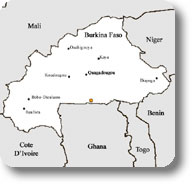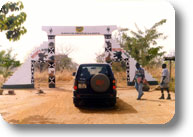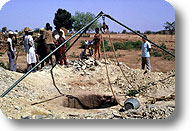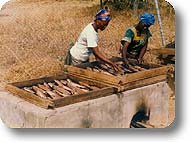
 |
Ranch de Gibier de Nazinga |
Protected Area |
|
 |
|
Ranch de Gibier de Nazinga Reserve |
|
 |
Ranch de Gibier de Nazinga, a government institution directly managed by the Ministry of the Environment of Burkina Faso (former Upper Volta), was born in 1973 as a wildlife protection area lying within a protected forest area. Thanks to a careful management of the relations with the existing villages and the building of some artificial lakes to favor the watering of the wildlife during the dry season, the wildlife consists of hundreds of elephants and buffaloes, thousands of antelopes and gazelles, several species of monkeys, birds, and reptiles. This Parks offers to the visitor two different philosophies to approach nature:
Around Ranch de Nazinga there are 11 villages mainly populated by the Gurunsi ethnic group, for an estimated total population of 2,600 inhabitants, partly consisting of families which once lived in the Park and have now been moved to the border area. |
The Twinning Project |
|
 |
Nazinga is also the name of a local village, where the Gurunsi live, one of the ancient ethnic groups populating the basin of the river Volta. Within the protected area, the agricultural, silviculture, and breeding activities are extremely limited and the good relationship between the Park and the local population cannot be taken for granted. In agreement with the Ranch authority, Ente Parchi e Riserve Cuneesi has focused its first initiatives of decentralized cooperation on this problem. In 1999, an Italian mission (self-financed by the participants) traveled to Nazinga, after the Executive Board of Ente Parchi e Riserve Naturali Cuneesi had decided to engage in a cooperation project aiming at:
Nazinga has been chosen since it is considered by the Burkinan Ministry of the Environment not only a protected area, but also a "lab". |
The Fair Projects |
|
 |
To reduce the consumption of timber in the dryers, they could work with the energy produced by solar panels. In order to experiment this system, it is necessary to collaborate with the Faculty of Agriculture of Turin which built another similar system in Niger. However, it should be said that, since this technology is not widespread, despite the ideal insolation conditions, this system gives serious problems linked to the maintenance and good working of the solar panels. The second project, which began in 2002 and dealt with apiculture, consisted of the purchase of wooden beehives, larger and easier to use during the honey extraction rather than the traditional ones made of terracotta. The beehives were then placed in some villages: in 2003 the honey extraction began, as well as the training of some beekeepers. The project will continue with the training of other persons in order to produce a more pure honey which, once met the needs of self-consumption, could be placed in the circuit of fair trade. Finally, during the previous years, the slaughterhouse of Nazinga Park was built, in order to offer better sanitary conditions to the meat of the hunted animals used for the consumption of the inhabitants of the villages and the tourists visiting the Park. Another initiative promoted by the Municipality of Boves regards the creation of the refectory for the school of Sya, favoring the presence of children coming from the farthest villages. The success of the first initiatives, together with the increasing interest in decentralized cooperation, led to strengthen the relationship with Nazinga through a project presented by a group of authorities led by the Municipality of Boves, in collaboration with Ente Parchi Riserve Naturali Cuneesi, the University of Turin - Faculty of Agriculture, the Province of Cuneo, Comunità Montana Gesso Vermenagna e Pesio, the Municipalities of Morozzo, Rocca de Baldi, Mondovì, and, of course, Regione Piemonte. The project aims at improving the level of alimentary safety both through the feasibility study linked to the introduction in the villages of a new technology for the drying up and conservation process of fresh products (dryer "Icaro"), already experimented in Sahel by the University of Turin, and through the renovation of the Park slaughterhouse, improving its sanitary and functional aspects. The participation in the project by the University of Turin has given the opportunity to start the first Italian project on the management of the Nazinga ecosystem, which is carried out by a student and followed by prof. Andrea Giordano of the Faculty of Agriculture. |
The Fishing Project |
|
 |
The first initiative of the twinning project with Ente Parchi Riserve Naturali Cuneesi was born: with two financing stages (for a total sum of Euros 20.000,00), we have provided support to eleven groups of women (one group in each village, for a total of about 400 women) to improve and increase the traditional activity of fish smoking. As a matter of fact, in Nazinga Park there are some artificial basins (dams dug into the earth) created to guarantee water to the wildlife; it is not allowed to use these structures for agricultural purposes, but fishing is allowed. Each village group has been provided with a two-wheel cart and a donkey, a smoking house and a small credit, while an animator and the staff of the Ranch have provided the necessary supervision and training. The women of the villages go in turns with their two-wheel cart to the lakes of the Park, where they buy fresh fish from authorized fishermen; they go then to the smoking center where the fish processing takes place. The fish processing lasts two or three days and means distances of some dozens of kilometers to cover. Finally, the fish is sold in the local markets, in the Park, and in the nearby town of Po. Repeating the operation a few times a year, each woman gets a significant income integration. Moreover, the presence of fish on the market leads to improve the traditional diet, which is mainly based on vegetables, thanks to the protein supply. During a second stage of the project, fishermen have been provided with new pirogues and nets, and with the adequate training regarding new fishing techniques. |